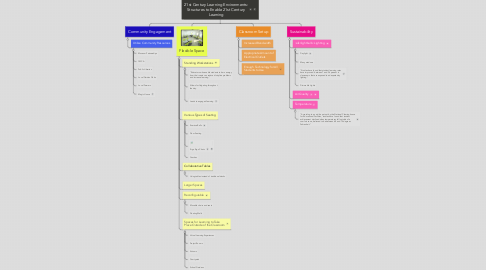
1. Flexible Space
1.1. Standing Workstations
1.1.1. "Educators who enable students to burn energy from their seats can reduce discipline problems and increase learning."
1.1.2. Allows for fidgeting throughout the day.
1.1.3. Leads to engaged learning
1.2. Various Types of Seating
1.2.1. Exercise Balls
1.2.2. Floor Seating
1.2.3. Ergo Ergo Chairs
1.2.4. Couches
1.3. Collaborative Tables
1.3.1. Using tables instead of traditional desks
1.4. Larger Spaces
1.5. Reconfigurable
1.5.1. Movable chairs and seats
1.5.2. Floating Walls
1.6. Spaces for Learning to Take Place Outside of the Classroom
1.6.1. Virtual Learning Experiences
1.6.2. Project Rooms
1.6.3. Atriums
1.6.4. Courtyards
1.6.5. School Gardens
2. Sustainability
2.1. Lighting
2.1.1. Daylight
2.1.2. Many windows
2.1.3. "Studies have found that student learning rates have improved between 7 and 26 percent in classrooms that are exposed to adequate day lighting."
2.1.4. Dimmable Lights
2.2. Air Quality
2.3. Temperature
2.3.1. "According to an article put out by the National Clearinghouse for Educational Facilities, studies have found that student achievement declined when temperatures fell outside of a comfort zone, believed to be between 68 and 74 degrees Fahrenheit."
3. Classroom Setup
3.1. Increased Bandwidth
3.2. Appropriate Amount of Electrical Outlets
3.3. Enough Technology for All Students to Use
4. Community Engagement
4.1. Utilize Community Resources
4.1.1. Museum Partnerships
4.1.2. YMCA
4.1.3. Public Libraries
4.1.4. Local Garden Clubs
4.1.5. Local Farmers
4.1.6. Magic House
